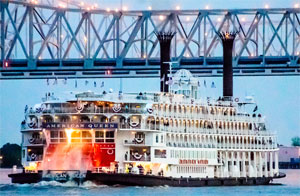A few years ago, nostalgic travel, whereby passengers were coddled in comfort aboard steam-powered paddle wheel cruises on the country’s inland rivers, appeared to be over. Not so. Last year the 418-foot steam-powered and sternwheeled American Queen, slipped its moorings on a sultry evening in New Orleans, did a turn in front of the French Quarter for show, and headed upriver en route to its home port of Memphis, Tenn.
American Queen was built in 1995 at McDermott Shipyard for the Delta Queen Steamboat Co., founded in 1890. Majestic America Line bought the company in 2006. It went broke in 2008.
In 2011, HMS Global Maritime bought the 436-passenger riverboat from the U.S. Maritime Administration and formed the Great American Steamboat Co. (recently renamed American Queen Steamboat Co.). The new company conducted a complete refurbishing of the interior and exterior of the vessel and upgraded the mechanical equipment at Bollinger Shipyards’ facilities in Sulphur and Amelia, La.
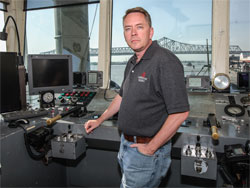 |
|
Capt. Greg Brown on the bridge as American Queen departs New Orleans. |
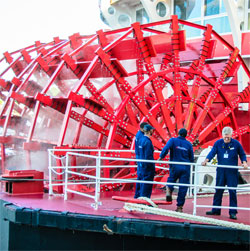 |
|
Crewmen at the paddle wheel. |
“She’s a modern classic,” said Capt. Greg Brown, the company’s vice president of marine operations. Brown, standing in the pilothouse surrounded by a bevy of high tech electronics monitored, integrated and controlled by a custom-built system by Ramtec Marine Systems, is in an environment where joysticks have replaced the big wheel.
The modern classic oxymoron also holds for the vessel’s propulsion. Two 750-hp Nordberg engines built in 1932, driven by steam from a Babcock & Wilcox single water tube type boiler, coincide with three 1,440 kW, rebuilt Caterpillar 3516 diesels, GE electric motors, two 1,000-hp Aquamaster Rolls-Royce z-drives and two Schottel 300-hp bow thrusters. The drives and thrusters are used for maneuvering in tight spots.
“It is very quiet, and it doesn’t get any louder the faster we go,” Fred Rich, the boat’s chief engineer, said while explaining the double reciprocating steam engines that pump connecting rods through a seven-foot stroke.
The rebuilt paddle wheel is 36 feet by 30 feet with 18 bucket boards made of fir. “The spoke extensions are made of oak,” said Marvin Williams, the company’s port engineer. “They use fir for the boards so they will break instead of the oak spokes. Kind of a sacrificial piece.”
There are two nine-foot-long by five-foot-high monkey rudders aft of the paddle wheel and two 17-foot by 5.75-foot main flanking rudders forward of the paddle wheel.
In the chart room, where there is a big wheel mounted for show, “riverlorians” Travis Vasconcelos and Mary Charlton prepare lectures and arm themselves against the barrage of questions they field from curious passengers. “We give talks about the river’s history, the lore both old and new,” said Charlton. “We love to bring the river alive.”
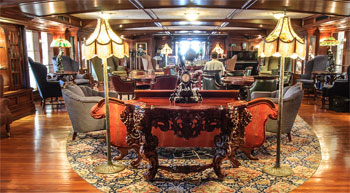 |
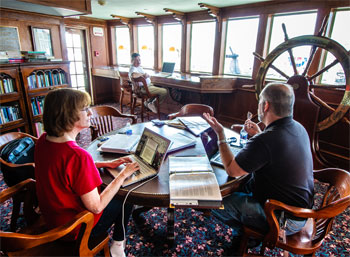 |
|
The lap of luxury in American Queen’s Mark Twain Gallery. |
Riverlorians Mary Charlton and Travis Vasconcelos in the chart room, with music engineer Bob Schad at the window. |
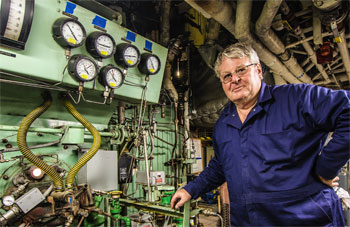 |
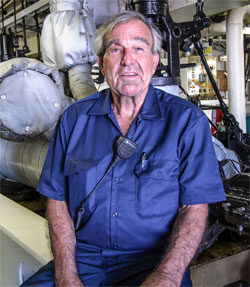 |
|
Thomas Benz, 2nd engineer, at the Babcock & Wilcox tube-type boiler with a Coen burner unit, generating 26,000 pounds of steam per hour and feeding the Kahlenberg steam whistle. |
Chief Engineer Fred Rich with a 750-hp Nordberg double reciprocating steam engine, built in 1932. |

